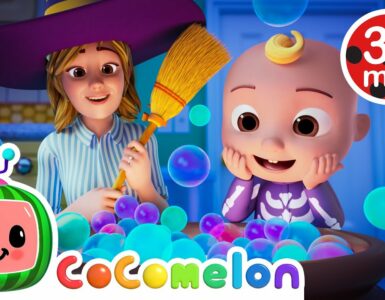In the Forest We Go Nursery Rhymes Lyrics:
In the forest, we go, we go, With the animals, high and low! Hop like a bunny, thump, thump, thump, Wiggle like a squirrel, jump, jump, jump! (Chorus) Oh, the forest is alive, hear the sounds! Growl, chirp, hoot, all around! Flap your wings, or scamper free, Dance with the animals, one, two, three!
In the forest, we see, we see, Owl in the tree, whoo, whoo, wee! Scurry like a mouse, squeak, squeak, squeak, Stomp like a bear, creak, creak, creak!
Oh, the forest is alive, hear the sounds! Growl, chirp, hoot, all around! Flap your wings, or scamper free, Dance with the animals, one, two, three!
Listen to the wind, it sings so sweet, Feel the leaves crunch under your feet! Spin like a deer, twirl, twirl, twirl, In the forest, let’s give it a whirl!
Oh, the forest is alive, hear the sounds! Growl, chirp, hoot, all around! Flap your wings, or scamper free, Dance with the animals, one, two, three!
In the forest, we go, we go, With the animals, high and low! Wave goodbye, till we meet again, Forest friends, you’re our best friend!
In the Forest We Go Nursery Rhymes – A Magical Adventure
In the Forest We Go Nursery Rhymes captivate children with their whimsical lyrics and repetitive melodies, serving as a gateway to imagination and learning. This article delves into the enchanting world of these timeless songs, exploring their history, educational value, and ways to integrate them into everyday life. Whether sung in a classroom or at home, In the Forest We Go Nursery Rhymes foster creativity and cognitive development, making them a staple in early childhood experiences. Join us as we uncover the magic behind these beloved rhymes and their lasting impact on young minds.
More: Wheels On The Ice Cream Truck Nursery Rhyme for Kids
The Origins of In the Forest We Go Nursery Rhymes
Nursery rhymes have long been a cornerstone of childhood, and In the Forest We Go stands out as a particularly evocative example, drawing children into a world of adventure and nature. This rhyme, with its themes of exploration and animal encounters, likely emerged from oral traditions where storytelling and song were intertwined. Historically, such rhymes served as tools for passing down cultural knowledge, moral lessons, and even historical events in a digestible format for the young. In the Forest We Go Nursery Rhymes, with their rhythmic structure and simple language, exemplify how these elements combine to create an enduring appeal. This section will trace the rhyme’s roots, examining its evolution and the cultural contexts that shaped it.
Early Development and Folk Influences
Nursery rhymes like In the Forest We Go often have murky origins, blending folk tales and community songs passed down through generations. Historians believe that many such rhymes originated in medieval Europe, where wandering minstrels and storytellers used simple verses to entertain and educate. In the case of In the Forest We Go, it may have drawn from ancient fables about forest adventures, symbolizing the unknown and the excitement of discovery. By the 18th and 19th centuries, as children’s literature began to formalize, rhymes were collected and published, with In the Forest We Go possibly appearing in early anthologies like those by Mother Goose figures.
The rhyme’s structure, with its repetitive phrases and call-and-response elements, mirrors traditional folk songs used in communal gatherings. This not only made it easy for children to learn and participate but also helped preserve oral histories. In rural communities, where forests were both a source of livelihood and mystery, songs like this one might have taught kids about nature’s dangers and wonders, embedding lessons in fun. Today, In the Forest We Go Nursery Rhymes continue to evoke this sense of wonder, reminding us of how folklore adapts to modern times while retaining its core essence.
As societies industrialized, nursery rhymes transitioned from oral traditions to printed media, with In the Forest We Go being adapted into books and educational materials. This shift allowed for wider dissemination, but it also meant that variations emerged based on regional dialects and cultural nuances. Despite these changes, the rhyme’s focus on exploration and imagination has remained constant, underscoring its timeless quality.
Key Figures and Historical Adaptations
Several key figures in children’s literature have influenced the popularity of rhymes like In the Forest We Go. For instance, 19th-century educators and authors, such as the Brothers Grimm or early compilers like John Newbery, played a role in standardizing nursery rhymes. In the Forest We Go might have been inspired by similar tales in their collections, where forest settings were common motifs for teaching morals. By the Victorian era, these rhymes were often illustrated in children’s books, adding a visual layer that enhanced their appeal.
Historical adaptations show how In the Forest We Go Nursery Rhymes evolved with societal changes. During the World Wars, for example, rhymes were sometimes altered to boost morale or convey messages of resilience, with forest themes symbolizing hope and escape. In educational reforms of the 20th century, psychologists like Piaget highlighted the cognitive benefits of such repetitive songs, leading to their integration into formal curricula. This evolution reflects a broader trend where nursery rhymes adapt to cultural shifts while maintaining their educational core.
In modern times, digital adaptations have further transformed In the Forest We Go, with animated versions and apps making it accessible to a global audience. Yet, the essence of the rhyme—its ability to spark imagination—remains unchanged, proving its resilience across eras.
Cultural Significance in Society
Beyond entertainment, In the Forest We Go Nursery Rhymes hold significant cultural value, often reflecting societal values and norms. In many cultures, forests represent the subconscious or the wild unknown, and this rhyme uses that symbolism to teach children about curiosity and caution. Historically, it may have servedas a way for communities to instill respect for nature while also entertaining young minds with tales of adventure.
In contemporary society, the cultural significance of nursery rhymes like In the Forest We Go extends into discussions about environmental stewardship. As conversations about climate change and conservation become increasingly prominent, rhymes that celebrate nature serve as a gentle reminder of childhood connections to the earth. They can cultivate early awareness about the importance of preserving natural habitats, thereby fostering a generation that appreciates and protects the environment.
This rhyme has also been utilized in various cultural contexts, such as in educational settings where diversity is celebrated. By incorporating different adaptations of In the Forest We Go from various cultures, educators can create an inclusive learning environment. The rhyme’s adaptability allows for unique interpretations that reflect diverse experiences and heritage, making it a valuable tool for multicultural education.
Moreover, modern-day performances of these nursery rhymes often incorporate elements of drama and visual art, allowing children to engage physically and creatively. This multi-disciplinary approach not only deepens their understanding but also creates lasting memories associated with the themes of exploration and wonder found within the forest.
Educational Benefits of In the Forest We Go Nursery Rhymes
Nursery rhymes serve not just as entertainment but also as essential building blocks in children’s cognitive and social development. In the Forest We Go is no exception, offering numerous educational benefits that extend far beyond simple memorization. This section will explore how this particular rhyme fosters language development, enhances emotional intelligence, and encourages social interaction among young learners.
Language Development through Repetition and Rhythm
One standout feature of nursery rhymes like In the Forest We Go is their rhythmic structure and repetitive nature, which are instrumental in aiding language acquisition. Children are naturally drawn to rhythm and repetition, making these songs an effective means of enhancing vocabulary and phonetic awareness. The simple yet engaging lyrics invite children to sing along, reinforcing their understanding of word sounds and patterns.
Engaging with In the Forest We Go allows children to experiment with language in a playful manner. The repetition of phrases not only solidifies memory retention but also gives them confidence in using new words. Additionally, the inherent storytelling aspect of the rhyme helps children grasp narrative structures, further developing their linguistic skills.
Parents and educators can amplify these benefits by encouraging interactive singing sessions where children can express themselves and even invent their own verses. This creativity nurtures linguistic flexibility, enabling young minds to explore language as a dynamic tool rather than a static set of rules.
Emotional Intelligence: Building Empathy through Songs
Another crucial educational aspect of In the Forest We Go Nursery Rhymes lies in their ability to foster emotional intelligence. As children immerse themselves in the whimsical adventures depicted in the rhyme, they encounter various emotions—curiosity, joy, fear, and excitement. Engaging with these feelings through song helps them identify and articulate their own emotions and those of others.
By discussing the scenarios presented in the rhyme, children learn to empathize with characters who experience challenges or uncertainties. For instance, they may relate to a character who feels scared while exploring the unknown parts of the forest, prompting discussions about overcoming fears or taking risks. Such conversations allow children to develop critical social skills, including empathy and problem-solving.
To enrich this experience, caregivers can facilitate role-playing activities based on the rhyme. Children can act out scenes and even create alternate endings, producing dialogue that reflects their feelings and perspectives. This active engagement reinforces emotional connections and cultivates resilience, equipping children with the tools needed to navigate their own emotional landscapes.
Social Interaction and Collaborative Learning
Lastly, In the Forest We Go serves as a catalyst for social interaction and collaborative learning, integral components of early childhood education. When sung in groups, the rhyme provides an opportunity for children to come together, promoting teamwork and community spirit. The collective experience of singing and moving to the rhythm fosters a sense of belonging and shared enjoyment.
Organizing group activities around the rhyme can enhance cooperative learning. For example, educators might split children into teams to create art inspired by the rhyme’s themes, encouraging collaboration and communication. These activities challenge children to articulate their ideas and negotiate solutions while cultivating friendships and social bonds.
Furthermore, incorporating movement into singing—like acting out animal encounters or mimicking forest elements—encourages physical expression and kinesthetic learning. This holistic approach to education not only makes learning enjoyable but also accommodates varying learning styles, ensuring all children can thrive.
Integrating In the Forest We Go into Daily Life
Incorporating nursery rhymes like In the Forest We Go into everyday activities offers a delightful way to enrich children’s lives with music and learning. From family sing-alongs to creative art projects, there are countless opportunities to seamlessly blend this enchanting song into daily routines. This section explores practical strategies for integrating the rhyme into home life, educational settings, and community interactions.
Family Sing-Alongs and Storytime Adventures
One of the simplest yet most effective ways to integrate In the Forest We Go into daily life is through family sing-alongs. Choosing a regular time each week for singing together creates joyful moments where families bond over music. Using instruments like tambourines or maracas can make singing even more interactive and fun, while allowing children to explore musicality and rhythm.
Pairing the rhyme with storytime can also deepen the experience. Parents can read related books that feature forests and adventure themes, drawing parallels between the stories and the rhyme. This blending of music and literature creates a richer narrative experience, inviting children to connect concepts and expand their understanding.
Additionally, incorporating hand motions or dance moves to accompany the song can make the experience multi-sensory, capturing children’s attention and encouraging physical activity. These family traditions help reinforce shared values and create cherished memories, ensuring that the magic of In the Forest We Go continues well into adulthood.
Classroom Activities and Learning Projects
Teachers can embrace the educational potential of In the Forest We Go by weaving it into the curriculum. Using it as a springboard, instructors can develop thematic units centered on nature and exploration. This could involve science lessons about local flora and fauna, art projects that encourage children to create their dream forest, or writing exercises where they craft their own forest adventures.
Incorporating outdoor play that aligns with the song’s themes can further magnify its impact. Organizing nature walks where children observe and discuss real trees, plants, and animal habitats allows for hands-on learning. Teachers can prompt discussions around what they see and hear, thus linking the experiences to the rhyme directly.
Collaboration among students can also be encouraged through group projects focused on creating a classroom display that embodies the forest theme. Whether crafting dioramas or collaborative murals, these artistic endeavors promote teamwork and critical thinking skills while keeping creativity at the forefront.
Community Engagement and Celebratory Events
The magic of In the Forest We Go can extend beyond home and school, reaching into community spaces as a tool for engagement. Organizing community events, such as forest-themed festivals or educational workshops, can be an exciting way to bring people together. Families can collaborate on crafts, performances, or storytelling sessions that highlight the song’s themes while emphasizing ecological awareness.
Local parks or nature reserves can serve as ideal venues for these celebrations. Activities like guided nature walks, scavenger hunts, and even puppet shows featuring characters from the rhyme invite participants to explore and appreciate their surroundings. Such events not only promote environmental consciousness but also strengthen community bonds.
Schools can also participate in wider community initiatives, like tree-planting days or nature conservation efforts, using In the Forest We Go as a motivational piece that inspires action towards protecting our planet. Engaging children in these meaningful activities brightens their understanding of the world and reinforces the idea that they can make a positive impact.
In summary, In the Forest We Go Nursery Rhymes serve as an invaluable resource in early childhood development. They provide historical insight into the evolution of storytelling and cultural practices while offering numerous educational benefits ranging from language development to emotional intelligence. Their whimsical nature makes them perfect for integration into daily life, whether through family sing-alongs, classroom projects, or community engagements. Ultimately, these enchanting rhymes continue to inspire curiosity, creativity, and a lasting appreciation for the wonders of nature, resonating with children and adults alike. Through the timeless charm of In the Forest We Go, we are reminded of the importance of imagination and connection to the world around us.
















